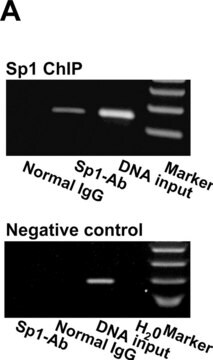17-10085
Magna ChIP® A/G Chromatin Immunoprecipitation Kit
Single day chromatin immunoprecipitation (ChIP) kit containing all necessary reagents to perform 22 individual chromatin immunoprecipitation (ChIP) reactions using magnetic A/G beads.
Synonym(s):
Magnetic ChIP Kit, Magnetic Chromatin Immunoprecipitation
About This Item
Recommended Products
Quality Level
manufacturer/tradename
Magna ChIP®
technique(s)
immunoprecipitation (IP): suitable
shipped in
dry ice
General description
- Magnetic bead-based rapid protocol allows performance of ChIP in as little as 1 day
- Blend of protein A+G bead blend allows ChIP using a broader range of antibodies than A or G alone
- Includes spin columns to make DNA purification easier and more reliable - no more messy phenol-chloroform extractions
- Complete kit with all required reagents for reliable and reproducible results
- Compatible with ChIPAb+ validated antibody and primer sets
Chromatin Immunoprecipitation (ChIP) is an important technique allowing the analysis of in vivo interactions of proteins with genomic DNA. Any chromatin-associated or DNA binding protein can be analyzed with this technique, provided a good antibody to the protein exists. One can measure different proteins localized to a specific region of the genome, or the genome wide distribution of a specific protein. Another powerful application of this technique is to analyze changes in histone modifications that correlate with processes like transcription, mitosis or DNA repair.
Application
Epigenetics & Nuclear Function
Packaging
Components
ChIP Dilution Buffer
Low Salt Wash Buffer
High Salt Wash Buffer
LiCl Wash Buffer
TE Buffer
Cell Lysis Buffer
Nuclear Lysis Buffer
ChIP Elution Buffer (w/o Proteinase K)
Proteinase K
RNase A
10X Glycine
10X PBS
Protease Inhibitor Cocktail II
Spin Filters
Collection Tubes
Bind Reagent A
Wash Reagent B
Elution Reagent C
Physical form
Storage and Stability
Legal Information
Disclaimer
Signal Word
Danger
Hazard Statements
Precautionary Statements
Hazard Classifications
Acute Tox. 4 Oral - Aquatic Chronic 3 - Eye Irrit. 2 - Flam. Liq. 2 - Resp. Sens. 1 - Skin Irrit. 2
Storage Class Code
3 - Flammable liquids
Flash Point(F)
55.4 °F
Flash Point(C)
13 °C
Certificates of Analysis (COA)
Search for Certificates of Analysis (COA) by entering the products Lot/Batch Number. Lot and Batch Numbers can be found on a product’s label following the words ‘Lot’ or ‘Batch’.
Already Own This Product?
Find documentation for the products that you have recently purchased in the Document Library.
Customers Also Viewed
Related Content
Protein and nucleic acid interaction reagents and resources for investing protein-RNA, protein-DNA, and protein-protein interactions and associated applications.
Our team of scientists has experience in all areas of research including Life Science, Material Science, Chemical Synthesis, Chromatography, Analytical and many others.
Contact Technical Service
















